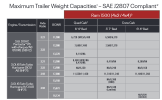I read the forum regarding 3.22 and 3.92 engineering guide to axle ratios, what has been posted here and what I obtained for my 2025 1500 LB Laramie for towing capacities from the Ram website
https://www.ramtrucks.com/content/d...rochure/25MY_Ram_1500_Customer_PayTow_2.0.pdf
View attachment 192725
Then I googled the question "
why does the 2025 ram 1500 Laramie have a higher trailer weight for the 3.99 axle" and got this AI response "The 2025 Ram 1500 Laramie has a higher trailer weight for the 3.99 axle because a higher axle ratio provides more towing power:"
Being an retired engineer and thinking of physics related issues, I have come to the preliminary conclusion:
- The truck's axles, framing and suspension can only support so much weight before one of the components fail like in post #16 above. Love that example.
- The truck's drive train (engine, transmission, transfer case, axles) can only produce enough force at any given speed to pull an object, hopefully on wheels.
- The truck's braking system can only apply so much force on the brakes to slow it down and any additional weight it is pulling. Hopefully the additional weight will have it's own braking system to assist the truck with its deceleration force assuming 100% traction all the time. (no skidding on road)
IDEAL SAFE CONDITION
With these 3 basic concepts and what has been mentioned in prior comments, you need to calculate all the weight put on the 4 wheels, this is the basic truck weight, all additional weight added since it came off the assembly line, and any weight added by trailers to the rear bumper or bed for 5th wheel trailers. If all this weight including passengers, food, beer, fat dog etc. that is added just before you drive down the driveway on a trip exceeds the weight specified in #1 above then you get post #16.
If you don't exceed #1 maximum weight rating then #2 comes into play. All the engine torque, transmission gear ratios or speeds, rear axle ratios and tire size and wind resistance while towing, impact what the truck can tow at a given speed and slope of the road. Faster you go more wind resistance, greater slop more gravity force resistance you need to overcome.
Once you do get your truck and trailer moving down the road #3 comes into play and what all the forward force and momentum you have created by getting all the stuff going down the highway at 60 mph. That requires LOTS of braking force on dry pavement to get you stopped. Thus; the total truck weight and towing capacity all add up to test your brakes, nerves and quality of tires that are now melting and brakes that are now on fire.....
My Question
Now my question to you wizards and referring to the towing capacities chart and #2 above: why wouldn't the engine rpm work in conjunction with the transmission gears to produce the required torque delivered to the wheels to pull trailers of various weights along the highway at 60 mph given none of the "Ideal Safe Conditions" are exceeded???
Wouldn't the transmission keep shifting around to find the sweet spot to keep you moving at 60 mph regardless of the gear ratio? I would think the higher axle ratio means lower engine rpm or higher transmission gear and visa versa for lower axle ratio?
Food for thought

Your technical thoughts?












